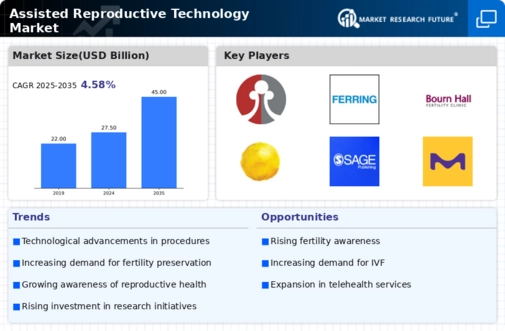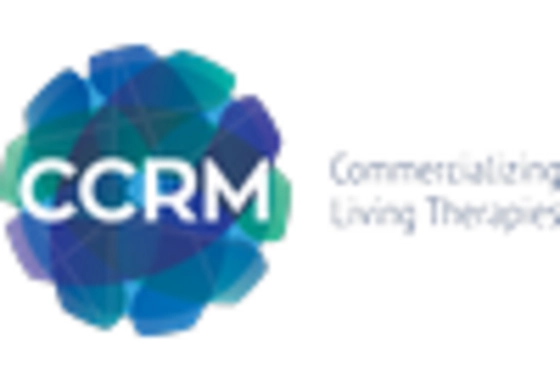In Vitro Fertilization
Intracytoplasmic Sperm Injection
Frozen Embryo Transfer
Egg Donation
Sperm Donation
Fertility Clinics
Hospitals
Home Care
Cryopreservation
Preimplantation Genetic Diagnosis
Assisted Hatching
Reagents
Consumables
Equipment
North America
Europe
South America
Asia Pacific
Middle East and Africa
North America Outlook (USD Billion, 2019-2035)
North America Assisted Reproductive Technology Market by Procedure Type
In Vitro Fertilization
Intracytoplasmic Sperm Injection
Frozen Embryo Transfer
Egg Donation
Sperm Donation
North America Assisted Reproductive Technology Market by End User Type
Fertility Clinics
Hospitals
Home Care
North America Assisted Reproductive Technology Market by Technology Type
Cryopreservation
Preimplantation Genetic Diagnosis
Assisted Hatching
North America Assisted Reproductive Technology Market by Product Type
Reagents
Consumables
Equipment
North America Assisted Reproductive Technology Market by Regional Type
US
Canada
US Outlook (USD Billion, 2019-2035)
US Assisted Reproductive Technology Market by Procedure Type
In Vitro Fertilization
Intracytoplasmic Sperm Injection
Frozen Embryo Transfer
Egg Donation
Sperm Donation
US Assisted Reproductive Technology Market by End User Type
Fertility Clinics
Hospitals
Home Care
US Assisted Reproductive Technology Market by Technology Type
Cryopreservation
Preimplantation Genetic Diagnosis
Assisted Hatching
US Assisted Reproductive Technology Market by Product Type
Reagents
Consumables
Equipment
CANADA Outlook (USD Billion, 2019-2035)
CANADA Assisted Reproductive Technology Market by Procedure Type
In Vitro Fertilization
Intracytoplasmic Sperm Injection
Frozen Embryo Transfer
Egg Donation
Sperm Donation
CANADA Assisted Reproductive Technology Market by End User Type
Fertility Clinics
Hospitals
Home Care
CANADA Assisted Reproductive Technology Market by Technology Type
Cryopreservation
Preimplantation Genetic Diagnosis
Assisted Hatching
CANADA Assisted Reproductive Technology Market by Product Type
Reagents
Consumables
Equipment
Europe Outlook (USD Billion, 2019-2035)
Europe Assisted Reproductive Technology Market by Procedure Type
In Vitro Fertilization
Intracytoplasmic Sperm Injection
Frozen Embryo Transfer
Egg Donation
Sperm Donation
Europe Assisted Reproductive Technology Market by End User Type
Fertility Clinics
Hospitals
Home Care
Europe Assisted Reproductive Technology Market by Technology Type
Cryopreservation
Preimplantation Genetic Diagnosis
Assisted Hatching
Europe Assisted Reproductive Technology Market by Product Type
Reagents
Consumables
Equipment
Europe Assisted Reproductive Technology Market by Regional Type
Germany
UK
France
Russia
Italy
Spain
Rest of Europe
GERMANY Outlook (USD Billion, 2019-2035)
GERMANY Assisted Reproductive Technology Market by Procedure Type
In Vitro Fertilization
Intracytoplasmic Sperm Injection
Frozen Embryo Transfer
Egg Donation
Sperm Donation
GERMANY Assisted Reproductive Technology Market by End User Type
Fertility Clinics
Hospitals
Home Care
GERMANY Assisted Reproductive Technology Market by Technology Type
Cryopreservation
Preimplantation Genetic Diagnosis
Assisted Hatching
GERMANY Assisted Reproductive Technology Market by Product Type
Reagents
Consumables
Equipment
UK Outlook (USD Billion, 2019-2035)
UK Assisted Reproductive Technology Market by Procedure Type
In Vitro Fertilization
Intracytoplasmic Sperm Injection
Frozen Embryo Transfer
Egg Donation
Sperm Donation
UK Assisted Reproductive Technology Market by End User Type
Fertility Clinics
Hospitals
Home Care
UK Assisted Reproductive Technology Market by Technology Type
Cryopreservation
Preimplantation Genetic Diagnosis
Assisted Hatching
UK Assisted Reproductive Technology Market by Product Type
Reagents
Consumables
Equipment
FRANCE Outlook (USD Billion, 2019-2035)
FRANCE Assisted Reproductive Technology Market by Procedure Type
In Vitro Fertilization
Intracytoplasmic Sperm Injection
Frozen Embryo Transfer
Egg Donation
Sperm Donation
FRANCE Assisted Reproductive Technology Market by End User Type
Fertility Clinics
Hospitals
Home Care
FRANCE Assisted Reproductive Technology Market by Technology Type
Cryopreservation
Preimplantation Genetic Diagnosis
Assisted Hatching
FRANCE Assisted Reproductive Technology Market by Product Type
Reagents
Consumables
Equipment
RUSSIA Outlook (USD Billion, 2019-2035)
RUSSIA Assisted Reproductive Technology Market by Procedure Type
In Vitro Fertilization
Intracytoplasmic Sperm Injection
Frozen Embryo Transfer
Egg Donation
Sperm Donation
RUSSIA Assisted Reproductive Technology Market by End User Type
Fertility Clinics
Hospitals
Home Care
RUSSIA Assisted Reproductive Technology Market by Technology Type
Cryopreservation
Preimplantation Genetic Diagnosis
Assisted Hatching
RUSSIA Assisted Reproductive Technology Market by Product Type
Reagents
Consumables
Equipment
ITALY Outlook (USD Billion, 2019-2035)
ITALY Assisted Reproductive Technology Market by Procedure Type
In Vitro Fertilization
Intracytoplasmic Sperm Injection
Frozen Embryo Transfer
Egg Donation
Sperm Donation
ITALY Assisted Reproductive Technology Market by End User Type
Fertility Clinics
Hospitals
Home Care
ITALY Assisted Reproductive Technology Market by Technology Type
Cryopreservation
Preimplantation Genetic Diagnosis
Assisted Hatching
ITALY Assisted Reproductive Technology Market by Product Type
Reagents
Consumables
Equipment
SPAIN Outlook (USD Billion, 2019-2035)
SPAIN Assisted Reproductive Technology Market by Procedure Type
In Vitro Fertilization
Intracytoplasmic Sperm Injection
Frozen Embryo Transfer
Egg Donation
Sperm Donation
SPAIN Assisted Reproductive Technology Market by End User Type
Fertility Clinics
Hospitals
Home Care
SPAIN Assisted Reproductive Technology Market by Technology Type
Cryopreservation
Preimplantation Genetic Diagnosis
Assisted Hatching
SPAIN Assisted Reproductive Technology Market by Product Type
Reagents
Consumables
Equipment
REST OF EUROPE Outlook (USD Billion, 2019-2035)
REST OF EUROPE Assisted Reproductive Technology Market by Procedure Type
In Vitro Fertilization
Intracytoplasmic Sperm Injection
Frozen Embryo Transfer
Egg Donation
Sperm Donation
REST OF EUROPE Assisted Reproductive Technology Market by End User Type
Fertility Clinics
Hospitals
Home Care
REST OF EUROPE Assisted Reproductive Technology Market by Technology Type
Cryopreservation
Preimplantation Genetic Diagnosis
Assisted Hatching
REST OF EUROPE Assisted Reproductive Technology Market by Product Type
Reagents
Consumables
Equipment
APAC Outlook (USD Billion, 2019-2035)
APAC Assisted Reproductive Technology Market by Procedure Type
In Vitro Fertilization
Intracytoplasmic Sperm Injection
Frozen Embryo Transfer
Egg Donation
Sperm Donation
APAC Assisted Reproductive Technology Market by End User Type
Fertility Clinics
Hospitals
Home Care
APAC Assisted Reproductive Technology Market by Technology Type
Cryopreservation
Preimplantation Genetic Diagnosis
Assisted Hatching
APAC Assisted Reproductive Technology Market by Product Type
Reagents
Consumables
Equipment
APAC Assisted Reproductive Technology Market by Regional Type
China
India
Japan
South Korea
Malaysia
Thailand
Indonesia
Rest of APAC
CHINA Outlook (USD Billion, 2019-2035)
CHINA Assisted Reproductive Technology Market by Procedure Type
In Vitro Fertilization
Intracytoplasmic Sperm Injection
Frozen Embryo Transfer
Egg Donation
Sperm Donation
CHINA Assisted Reproductive Technology Market by End User Type
Fertility Clinics
Hospitals
Home Care
CHINA Assisted Reproductive Technology Market by Technology Type
Cryopreservation
Preimplantation Genetic Diagnosis
Assisted Hatching
CHINA Assisted Reproductive Technology Market by Product Type
Reagents
Consumables
Equipment
INDIA Outlook (USD Billion, 2019-2035)
INDIA Assisted Reproductive Technology Market by Procedure Type
In Vitro Fertilization
Intracytoplasmic Sperm Injection
Frozen Embryo Transfer
Egg Donation
Sperm Donation
INDIA Assisted Reproductive Technology Market by End User Type
Fertility Clinics
Hospitals
Home Care
INDIA Assisted Reproductive Technology Market by Technology Type
Cryopreservation
Preimplantation Genetic Diagnosis
Assisted Hatching
INDIA Assisted Reproductive Technology Market by Product Type
Reagents
Consumables
Equipment
JAPAN Outlook (USD Billion, 2019-2035)
JAPAN Assisted Reproductive Technology Market by Procedure Type
In Vitro Fertilization
Intracytoplasmic Sperm Injection
Frozen Embryo Transfer
Egg Donation
Sperm Donation
JAPAN Assisted Reproductive Technology Market by End User Type
Fertility Clinics
Hospitals
Home Care
JAPAN Assisted Reproductive Technology Market by Technology Type
Cryopreservation
Preimplantation Genetic Diagnosis
Assisted Hatching
JAPAN Assisted Reproductive Technology Market by Product Type
Reagents
Consumables
Equipment
SOUTH KOREA Outlook (USD Billion, 2019-2035)
SOUTH KOREA Assisted Reproductive Technology Market by Procedure Type
In Vitro Fertilization
Intracytoplasmic Sperm Injection
Frozen Embryo Transfer
Egg Donation
Sperm Donation
SOUTH KOREA Assisted Reproductive Technology Market by End User Type
Fertility Clinics
Hospitals
Home Care
SOUTH KOREA Assisted Reproductive Technology Market by Technology Type
Cryopreservation
Preimplantation Genetic Diagnosis
Assisted Hatching
SOUTH KOREA Assisted Reproductive Technology Market by Product Type
Reagents
Consumables
Equipment
MALAYSIA Outlook (USD Billion, 2019-2035)
MALAYSIA Assisted Reproductive Technology Market by Procedure Type
In Vitro Fertilization
Intracytoplasmic Sperm Injection
Frozen Embryo Transfer
Egg Donation
Sperm Donation
MALAYSIA Assisted Reproductive Technology Market by End User Type
Fertility Clinics
Hospitals
Home Care
MALAYSIA Assisted Reproductive Technology Market by Technology Type
Cryopreservation
Preimplantation Genetic Diagnosis
Assisted Hatching
MALAYSIA Assisted Reproductive Technology Market by Product Type
Reagents
Consumables
Equipment
THAILAND Outlook (USD Billion, 2019-2035)
THAILAND Assisted Reproductive Technology Market by Procedure Type
In Vitro Fertilization
Intracytoplasmic Sperm Injection
Frozen Embryo Transfer
Egg Donation
Sperm Donation
THAILAND Assisted Reproductive Technology Market by End User Type
Fertility Clinics
Hospitals
Home Care
THAILAND Assisted Reproductive Technology Market by Technology Type
Cryopreservation
Preimplantation Genetic Diagnosis
Assisted Hatching
THAILAND Assisted Reproductive Technology Market by Product Type
Reagents
Consumables
Equipment
INDONESIA Outlook (USD Billion, 2019-2035)
INDONESIA Assisted Reproductive Technology Market by Procedure Type
In Vitro Fertilization
Intracytoplasmic Sperm Injection
Frozen Embryo Transfer
Egg Donation
Sperm Donation
INDONESIA Assisted Reproductive Technology Market by End User Type
Fertility Clinics
Hospitals
Home Care
INDONESIA Assisted Reproductive Technology Market by Technology Type
Cryopreservation
Preimplantation Genetic Diagnosis
Assisted Hatching
INDONESIA Assisted Reproductive Technology Market by Product Type
Reagents
Consumables
Equipment
REST OF APAC Outlook (USD Billion, 2019-2035)
REST OF APAC Assisted Reproductive Technology Market by Procedure Type
In Vitro Fertilization
Intracytoplasmic Sperm Injection
Frozen Embryo Transfer
Egg Donation
Sperm Donation
REST OF APAC Assisted Reproductive Technology Market by End User Type
Fertility Clinics
Hospitals
Home Care
REST OF APAC Assisted Reproductive Technology Market by Technology Type
Cryopreservation
Preimplantation Genetic Diagnosis
Assisted Hatching
REST OF APAC Assisted Reproductive Technology Market by Product Type
Reagents
Consumables
Equipment
South America Outlook (USD Billion, 2019-2035)
South America Assisted Reproductive Technology Market by Procedure Type
In Vitro Fertilization
Intracytoplasmic Sperm Injection
Frozen Embryo Transfer
Egg Donation
Sperm Donation
South America Assisted Reproductive Technology Market by End User Type
Fertility Clinics
Hospitals
Home Care
South America Assisted Reproductive Technology Market by Technology Type
Cryopreservation
Preimplantation Genetic Diagnosis
Assisted Hatching
South America Assisted Reproductive Technology Market by Product Type
Reagents
Consumables
Equipment
South America Assisted Reproductive Technology Market by Regional Type
Brazil
Mexico
Argentina
Rest of South America
BRAZIL Outlook (USD Billion, 2019-2035)
BRAZIL Assisted Reproductive Technology Market by Procedure Type
In Vitro Fertilization
Intracytoplasmic Sperm Injection
Frozen Embryo Transfer
Egg Donation
Sperm Donation
BRAZIL Assisted Reproductive Technology Market by End User Type
Fertility Clinics
Hospitals
Home Care
BRAZIL Assisted Reproductive Technology Market by Technology Type
Cryopreservation
Preimplantation Genetic Diagnosis
Assisted Hatching
BRAZIL Assisted Reproductive Technology Market by Product Type
Reagents
Consumables
Equipment
MEXICO Outlook (USD Billion, 2019-2035)
MEXICO Assisted Reproductive Technology Market by Procedure Type
In Vitro Fertilization
Intracytoplasmic Sperm Injection
Frozen Embryo Transfer
Egg Donation
Sperm Donation
MEXICO Assisted Reproductive Technology Market by End User Type
Fertility Clinics
Hospitals
Home Care
MEXICO Assisted Reproductive Technology Market by Technology Type
Cryopreservation
Preimplantation Genetic Diagnosis
Assisted Hatching
MEXICO Assisted Reproductive Technology Market by Product Type
Reagents
Consumables
Equipment
ARGENTINA Outlook (USD Billion, 2019-2035)
ARGENTINA Assisted Reproductive Technology Market by Procedure Type
In Vitro Fertilization
Intracytoplasmic Sperm Injection
Frozen Embryo Transfer
Egg Donation
Sperm Donation
ARGENTINA Assisted Reproductive Technology Market by End User Type
Fertility Clinics
Hospitals
Home Care
ARGENTINA Assisted Reproductive Technology Market by Technology Type
Cryopreservation
Preimplantation Genetic Diagnosis
Assisted Hatching
ARGENTINA Assisted Reproductive Technology Market by Product Type
Reagents
Consumables
Equipment
REST OF SOUTH AMERICA Outlook (USD Billion, 2019-2035)
REST OF SOUTH AMERICA Assisted Reproductive Technology Market by Procedure Type
In Vitro Fertilization
Intracytoplasmic Sperm Injection
Frozen Embryo Transfer
Egg Donation
Sperm Donation
REST OF SOUTH AMERICA Assisted Reproductive Technology Market by End User Type
Fertility Clinics
Hospitals
Home Care
REST OF SOUTH AMERICA Assisted Reproductive Technology Market by Technology Type
Cryopreservation
Preimplantation Genetic Diagnosis
Assisted Hatching
REST OF SOUTH AMERICA Assisted Reproductive Technology Market by Product Type
Reagents
Consumables
Equipment
MEA Outlook (USD Billion, 2019-2035)
MEA Assisted Reproductive Technology Market by Procedure Type
In Vitro Fertilization
Intracytoplasmic Sperm Injection
Frozen Embryo Transfer
Egg Donation
Sperm Donation
MEA Assisted Reproductive Technology Market by End User Type
Fertility Clinics
Hospitals
Home Care
MEA Assisted Reproductive Technology Market by Technology Type
Cryopreservation
Preimplantation Genetic Diagnosis
Assisted Hatching
MEA Assisted Reproductive Technology Market by Product Type
Reagents
Consumables
Equipment
MEA Assisted Reproductive Technology Market by Regional Type
GCC Countries
South Africa
Rest of MEA
GCC COUNTRIES Outlook (USD Billion, 2019-2035)
GCC COUNTRIES Assisted Reproductive Technology Market by Procedure Type
In Vitro Fertilization
Intracytoplasmic Sperm Injection
Frozen Embryo Transfer
Egg Donation
Sperm Donation
GCC COUNTRIES Assisted Reproductive Technology Market by End User Type
Fertility Clinics
Hospitals
Home Care
GCC COUNTRIES Assisted Reproductive Technology Market by Technology Type
Cryopreservation
Preimplantation Genetic Diagnosis
Assisted Hatching
GCC COUNTRIES Assisted Reproductive Technology Market by Product Type
Reagents
Consumables
Equipment
SOUTH AFRICA Outlook (USD Billion, 2019-2035)
SOUTH AFRICA Assisted Reproductive Technology Market by Procedure Type
In Vitro Fertilization
Intracytoplasmic Sperm Injection
Frozen Embryo Transfer
Egg Donation
Sperm Donation
SOUTH AFRICA Assisted Reproductive Technology Market by End User Type
Fertility Clinics
Hospitals
Home Care
SOUTH AFRICA Assisted Reproductive Technology Market by Technology Type
Cryopreservation
Preimplantation Genetic Diagnosis
Assisted Hatching
SOUTH AFRICA Assisted Reproductive Technology Market by Product Type
Reagents
Consumables
Equipment
REST OF MEA Outlook (USD Billion, 2019-2035)
REST OF MEA Assisted Reproductive Technology Market by Procedure Type
In Vitro Fertilization
Intracytoplasmic Sperm Injection
Frozen Embryo Transfer
Egg Donation
Sperm Donation
REST OF MEA Assisted Reproductive Technology Market by End User Type
Fertility Clinics
Hospitals
Home Care
REST OF MEA Assisted Reproductive Technology Market by Technology Type
Cryopreservation
Preimplantation Genetic Diagnosis
Assisted Hatching
REST OF MEA Assisted Reproductive Technology Market by Product Type
Reagents
Consumables
Equipment

















Leave a Comment